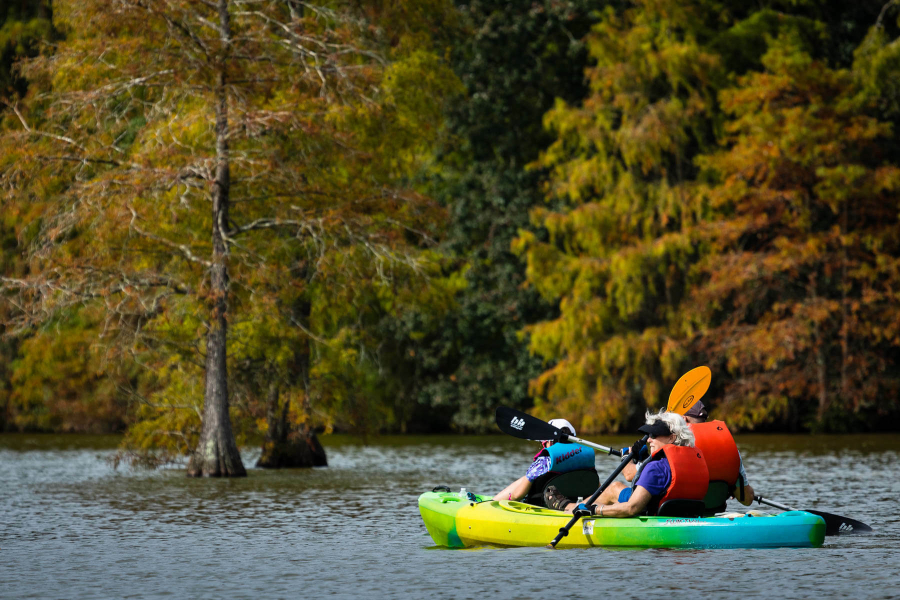5 reasons to fall in love with autumn in the Chesapeake

Here’s a pumpkin covered hill I’ll die on: no region can compete with the Chesapeake Bay watershed when it comes to the fall season. Sure, the Midwest might have superior leaf peeping. New England is likely the witch capital of the U.S. But when you put together all the things that make autumn awesome, our watershed sits highest on the hay bale.
Our fall foliage will leaf you breathless
The Chesapeake Bay watershed is brimming with parks, forests and mountain ranges displaying incredible fall colors—far too many to mention here. Shenandoah National Park and Skyline Drive rank among the nation’s top places to see fall leaves, while Harper’s Ferry, the Chesapeake & Ohio Canal Trail and Trap Pond State Park each offer a delightful experience of their own. If you’re looking for a unique attraction, Pennsylvania boasts over 200 nostalgic covered bridges, including one on Gravity Hill where cars mysteriously roll uphill. There are also numerous historic downtowns throughout the watershed where autumn colored tree canopy brings the season to life.
Apples are core to our region
If you’re looking to get your apple picking, cider sipping, donut dipping fix, look no further than the upper watershed. The Historic South Mountain Fruit Belt in Adams County, Pennsylvania is the sixth largest producer of apples in the nation, and it is also home to the National Apple Harvest Festival. New York is known for its apple orchards, too, but even more so for its apple cider and apple cider donuts. The state is jam-packed with cider mills and distilleries big and small, many of which are within the Chesapeake Bay watershed. If that weren’t enough, North America’s first apples were grown in the watershed in what is now the Commonwealth of Virginia by Jamestown colonists in 1607.
The Bay states scream “spooky”
You won’t find this on many tourism billboards, but the Chesapeake Bay watershed is home to some of America’s best ghost stories. Civil War battlefields, historic lighthouses and hiking trails are said to be visited by those from beyond the grave. At the bottom of Mallows Bay in the Potomac River lies the greatest concentration of sunken ships in North America. Even our native wildlife can be terrifying, including the infamous dead man’s fingers. With all this spookiness, it’s no wonder that Edgar Allen Poe wrote some of his most terrifying tales in Baltimore, Maryland, a stone’s throw from the Inner Harbor.
Pumpkin patches, festivals and Oktoberfest
Three pumpkin patches within the watershed regularly rank among America’s best fall farm attractions: Jumbo’s Pumpkin Patch in Maryland and Chesterfield Berry Farms and Cox Farms in Virginia. These farms go well beyond your typical pumpkin patch with tractor rides, haunted houses, petting zoos, giant slides, replica trains and other family-friendly activities. In Pennsylvania, the Commonwealth’s rich German ancestry makes for extensive Oktoberfest celebrations. And in New York, you’ll find various apple cider festivals, including Cider Week New York.
Indigenous and colonial history
It’s commonly taught that the first Thanksgiving took place in Plymouth, Massachusetts, but some historians would argue that two years prior, a Thanksgiving meal took place right off the James River! No matter where Thanksgiving first occurred, the Chesapeake Bay watershed has numerous historic sites that are important to both colonial historians and Indigenous tribes. We’ve got Werowocomoco, Machicomoco State Park and the Susquehanna petroglyphs, as well as Historic Jamestown, Old Bedford Village and the Captain John Smith Chesapeake Trail, to name a few.
Is there a fall attraction in the Chesapeake watershed that we didn’t mention? Let us know in the comments!

Comments
There are no comments.
Thank you!
Your comment has been received. Before it can be published, the comment will be reviewed by our team to ensure it adheres with our rules of engagement.
Back to recent stories